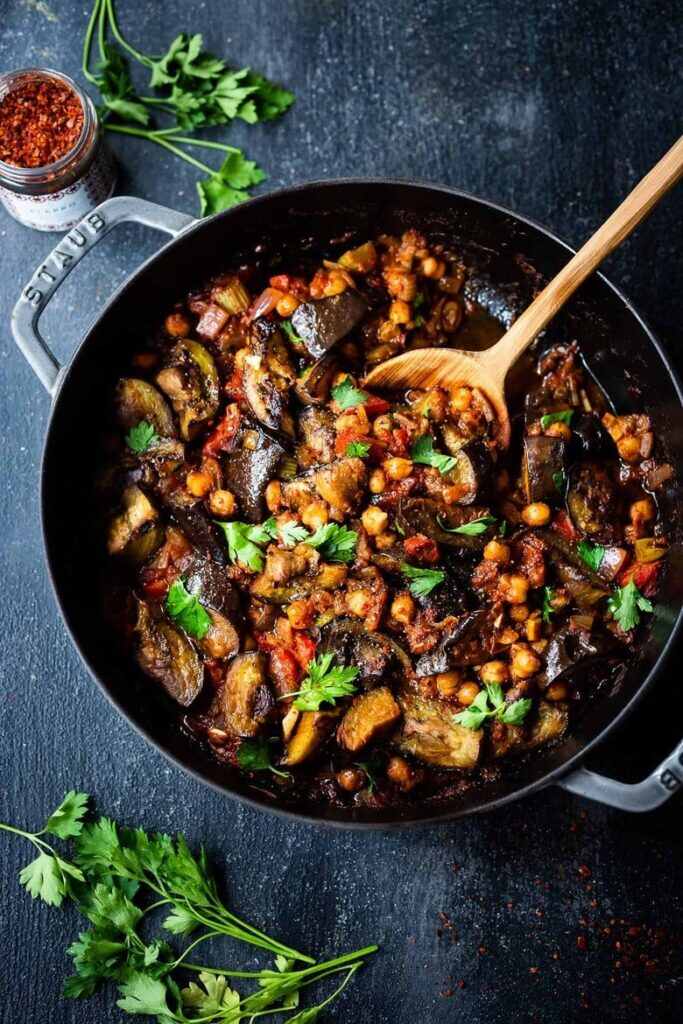Eggplant and Chickpea Tagine is a flavorful and hearty North African dish that combines the rich textures of eggplant and the protein-packed goodness of chickpeas, cooked together in a fragrant blend of spices. This traditional tagine, inspired by Moroccan cuisine, typically includes ingredients like tomatoes, onions, garlic, and a medley of aromatic spices such as cumin, coriander, and cinnamon. The dish is slow-cooked in a tagine, a traditional North African cooking vessel, allowing the flavors to meld and intensify. The result is a savory, slightly sweet, and satisfying vegetarian or vegan dish that can be served on its own or with couscous or bread. Eggplant and Chickpea Tagine is not only delicious but also a celebration of the vibrant and diverse flavors found in North African culinary traditions.
| Ingredients | |
| 1 | 1 large eggplant, diced |
| 2 | 1 can (15 oz) chickpeas, drained and rinsed |
| 3 | 1 onion, finely chopped |
| 4 | 3 cloves garlic, minced |
| 5 | 2 large tomatoes, diced |
| 6 | 1/4 cup tomato paste |
| 7 | 1/4 cup olive oil |
| 8 | 1 teaspoon ground cumin |
| 9 | 1 teaspoon ground coriander |
| 10 | 1/2 teaspoon ground cinnamon |
| 11 | 1/2 teaspoon smoked paprika |
| 12 | 1/4 teaspoon cayenne pepper (adjust to taste) |
| 13 | Salt and pepper to taste |
| 14 | 1 cup vegetable broth |
| 15 | Fresh cilantro or parsley for garnish |
| 16 | Lemon wedges for serving |
Step-by-step cooking instruction of Eggplant and Chickpea Tagine:
Step-1 Prepare the Eggplant:
- Dice the eggplant into bite-sized cubes.
- Sprinkle the cubes with salt and let them sit for about 15-20 minutes. This aids in getting rid of the eggplant’s extra moisture and bitterness.
- Using paper towels, pat the eggplant dry after 20 minutes.
Step-2 Sauté Onion and Garlic:
- Heat olive oil in a tagine or large, deep skillet over medium heat.
- Add chopped onions and sauté until softened and translucent.
- Add the minced garlic and simmer, stirring, for one to two more minutes, or until fragrant.
Step-3 Add Spices: Add ground cumin, ground coriander, ground cinnamon, smoked paprika, cayenne pepper, salt, and pepper to the onion-garlic mixture. Stir well to coat the onions with the spices.
Step-4 Cook Eggplant: Add the diced and dried eggplant to the spice mixture. Stir to combine and let it cook for about 5-7 minutes until the eggplant starts to brown.
Step-5 Combine Tomatoes and Tomato Paste: Add diced tomatoes and tomato paste to the eggplant mixture. Stir well to combine all ingredients.
Step-6 Add Chickpeas and Vegetable Broth:
- Add the drained and rinsed chickpeas to the tagine.
- Pour in vegetable broth and stir everything together.
Step-7 Simmer: Cover the tagine or skillet with a lid and reduce the heat to low. For the veggies to soften and the flavors to combine, boil the mixture for 20 to 25 minutes.
Step-8 Adjust Seasoning: Taste the tagine and adjust the seasoning if necessary. To taste, increase the amount of spices, salt, or pepper.
Step-9 Garnish and Serve:
- Take the tagine off of the heat as soon as the vegetables are soft.
- Garnish with fresh cilantro or parsley.
Step-10 Serve:
- Serve the Eggplant and Chickpea Tagine hot, either on its own or with couscous, rice, or crusty bread.
- Optionally, serve with lemon wedges for a burst of citrus flavor.
Nutritional values of Eggplant and Chickpea Tagine:
The nutritional values of Eggplant and Chickpea Tagine can vary based on specific ingredients, portion sizes, and preparation methods. Below is a general overview of the key nutritional components found in this dish, per serving:
| 1 | Calories: Around 250-300 calories per serving. |
| 2 | Protein: 8-10 grams per serving (can be higher if served with couscous or other protein sources). |
| 3 | Fat: 10-15 grams per serving, primarily from olive oil and any added fats. |
| 4 | Carbohydrates: 35-40 grams per serving, mainly from chickpeas and vegetables. |
| 5 | Fiber: 10-12 grams per serving, owing to the presence of chickpeas and vegetables. |
| Vitamins and Minerals: Rich in vitamins A and C, potassium, magnesium, and other essential nutrients provided by eggplant, chickpeas, and vegetables. | |
| 7 | Low in Saturated Fat and Cholesterol: Eggplant and Chickpea Tagine is a heart-healthy dish due to its low saturated fat and cholesterol content. |
Background History of Eggplant and Chickpea Tagine:
The Eggplant and Chickpea Tagine is inspired by the rich culinary traditions of North Africa, particularly Moroccan cuisine. Tagine refers to both the dish itself and the traditional clay or ceramic cooking vessel with a cone-shaped lid that is used to prepare it. This slow-cooking method allows flavors to meld and intensify, creating a uniquely fragrant and savory dish.
The history of the Eggplant and Chickpea Tagine is deeply rooted in the diverse and vibrant food culture of the Maghreb region, which includes Morocco, Algeria, Tunisia, Libya, and Mauritania. Morocco, in particular, is renowned for its tagine dishes, characterized by the use of aromatic spices, slow cooking, and a combination of various ingredients.
Eggplants, also known as aubergines, have been cultivated in the Mediterranean region for centuries and became a staple in many Middle Eastern and North African cuisines. Chickpeas, another key ingredient in the tagine, have a long history in the region as well, being a common part of the Mediterranean diet.
The use of spices like cumin, coriander, cinnamon, and paprika in Moroccan cuisine reflects the influence of trade routes and historical connections with various cultures, including Arab, Berber, and Andalusian.
While the exact origin of the Eggplant and Chickpea Tagine may be challenging to trace, it is undoubtedly a product of the diverse culinary heritage and cultural exchange that has shaped North African cuisine over the centuries. Today, this dish continues to be a popular and beloved representation of the region’s flavorful and aromatic gastronomy, enjoyed by people around the world.
| Advantages of Eggplant and Chickpea Tagine | |
| 1 | Nutrient-Rich Ingredients: The tagine is packed with nutrient-dense ingredients such as eggplant, chickpeas, tomatoes, and various spices, providing a good balance of vitamins, minerals, fiber, and antioxidants. |
| 2 | Vegetarian or Vegan Option: It offers a delicious and satisfying vegetarian or vegan meal, making it suitable for individuals with dietary preferences or restrictions. |
| 3 | Heart-Healthy: The use of olive oil and the absence of saturated fats in the tagine contribute to heart-healthy qualities, promoting cardiovascular well-being. |
| 4 | Rich in Fiber: Chickpeas and vegetables contribute a significant amount of dietary fiber, aiding digestion and promoting a feeling of fullness. |
| 5 | Aromatic and Flavorful: The slow-cooking method allows the flavors to meld, creating a dish that is rich, aromatic, and deeply flavorful. |
| 6 | Cultural Exploration: Preparing Eggplant and Chickpea Tagine offers an opportunity to explore and appreciate the diverse and delicious flavors of North African cuisine. |
| Disadvantages of Eggplant and Chickpea Tagine | |
| 1 | High in Calories and Fat: Depending on the amount of olive oil used, the dish can be relatively high in calories and fat. While olive oil is a healthy fat, moderation is key. |
| 2 | Preparation Time: The tagine requires some time for preparation and slow cooking, which might be a disadvantage for those seeking quick and convenient meals. |
| 3 | Allergies and Sensitivities: Individuals with allergies or sensitivities to specific ingredients, such as nightshades (eggplants), should be cautious when consuming this dish. |
| 4 | Specific Equipment: Cooking in a traditional tagine requires access to the specialized clay or ceramic vessel. While alternatives like a Dutch oven can be used, it may not capture the authenticity of the traditional cooking method. |
| 5 | Acquired Taste: The bold flavors and aromatic spices may not be appealing to everyone, and preferences for certain spices may vary. |
| 6 | Potential for Overcooking: Inexperienced cooks may face challenges in achieving the right balance of tenderness without overcooking the vegetables, as the slow-cooking process can be delicate. |
Compare with Similar meal of Eggplant and Chickpea Tagine:
If you enjoy the flavors and ingredients in Eggplant and Chickpea Tagine, you might also appreciate other dishes with a Mediterranean or Middle Eastern influence. Here are some similar meals that share similar elements of rich flavors, vegetables, and spices:
| 1 | Vegetarian Moussaka: Layers of roasted eggplant, potatoes, and a flavorful tomato and lentil sauce, topped with a creamy béchamel. It’s a hearty and satisfying dish. |
| 2 | Chana Masala: A North Indian dish featuring chickpeas in a spiced tomato-based sauce. It’s usually served with rice or flatbread and garnished with cilantro. |
| 3 | Ratatouille: A French Provençal vegetable stew made with eggplant, zucchini, bell peppers, onions, and tomatoes. It’s seasoned with herbs like thyme and rosemary. |
| 4 | Caponata: An Italian eggplant dish with tomatoes, olives, and capers, all cooked in a sweet and sour sauce made from vinegar and sugar. It’s typically served as an appetizer or side dish. |
| 5 | Shakshuka: A North African and Middle Eastern dish where eggs are poached in a spiced tomato and bell pepper sauce. It’s often seasoned with cumin, paprika, and cayenne. |
| 6 | Lentil and Vegetable Stew: A hearty stew featuring lentils, various vegetables, and aromatic spices. It’s a nutritious and filling option, often served with rice or crusty bread. |
| 7 | Mediterranean Stuffed Peppers: Bell peppers filled with a mixture of rice, chickpeas, tomatoes, and Mediterranean herbs, then baked until tender. |
| 8 | Vegetable Biryani: A fragrant and flavorful Indian dish made with basmati rice, mixed vegetables, and aromatic spices. Fresh herbs and fried onions are common garnishes. |
Mostly questions asked about Eggplant and Chickpea Tagine
1: Is Eggplant and Chickpea Tagine vegan?
A: Yes, Eggplant and Chickpea Tagine is often vegan. It typically contains no animal products, making it a suitable option for a plant-based diet.
2: Can I use a regular pot instead of a tagine for cooking?
A: Yes, you can use a regular pot or a Dutch oven as a substitute for a tagine. While the traditional tagine has its unique properties, other cookware can still produce a delicious dish.
3: Can I prepare Eggplant and Chickpea Tagine in advance?
A: Yes, Eggplant and Chickpea Tagine can be prepared in advance and reheated. In fact, many people find that the flavors intensify when allowed to meld overnight.
4: What can I serve with Eggplant and Chickpea Tagine?
A: It pairs well with couscous, rice, quinoa, or crusty bread. The grains or bread help soak up the flavorful sauce.
5: Can I freeze Eggplant and Chickpea Tagine?
A: Yes, you can freeze Eggplant and Chickpea Tagine. Let it cool completely before moving it to a container that can be frozen. When ready to eat, thaw and reheat.
6: How do I adjust the spice level in the tagine?
A: To control the spice level, adjust the amount of cayenne pepper or omit it altogether. You can also customize the spice blend according to your preference.
7: Are there variations of Eggplant and Chickpea Tagine?
A: Yes, there are many variations. Some recipes include additional vegetables like bell peppers or carrots. Others may incorporate different spices or herbs to suit individual tastes.
8: Is this dish gluten-free?
A: Yes, Eggplant and Chickpea Tagine is typically gluten-free. However, it’s crucial to check specific ingredient labels, especially for items like vegetable broth or spice blends.
9: Can I substitute chickpeas with another legume?
A: Yes, you can substitute chickpeas with other legumes like lentils or white beans, adjusting the cooking time accordingly.
10: What do I do if the eggplant is bitter?
A: If the eggplant tastes bitter, try salting it and letting it sit for 15-20 minutes before cooking. This process can help draw out bitterness. Rinse the eggplant thoroughly and pat it dry before using.







